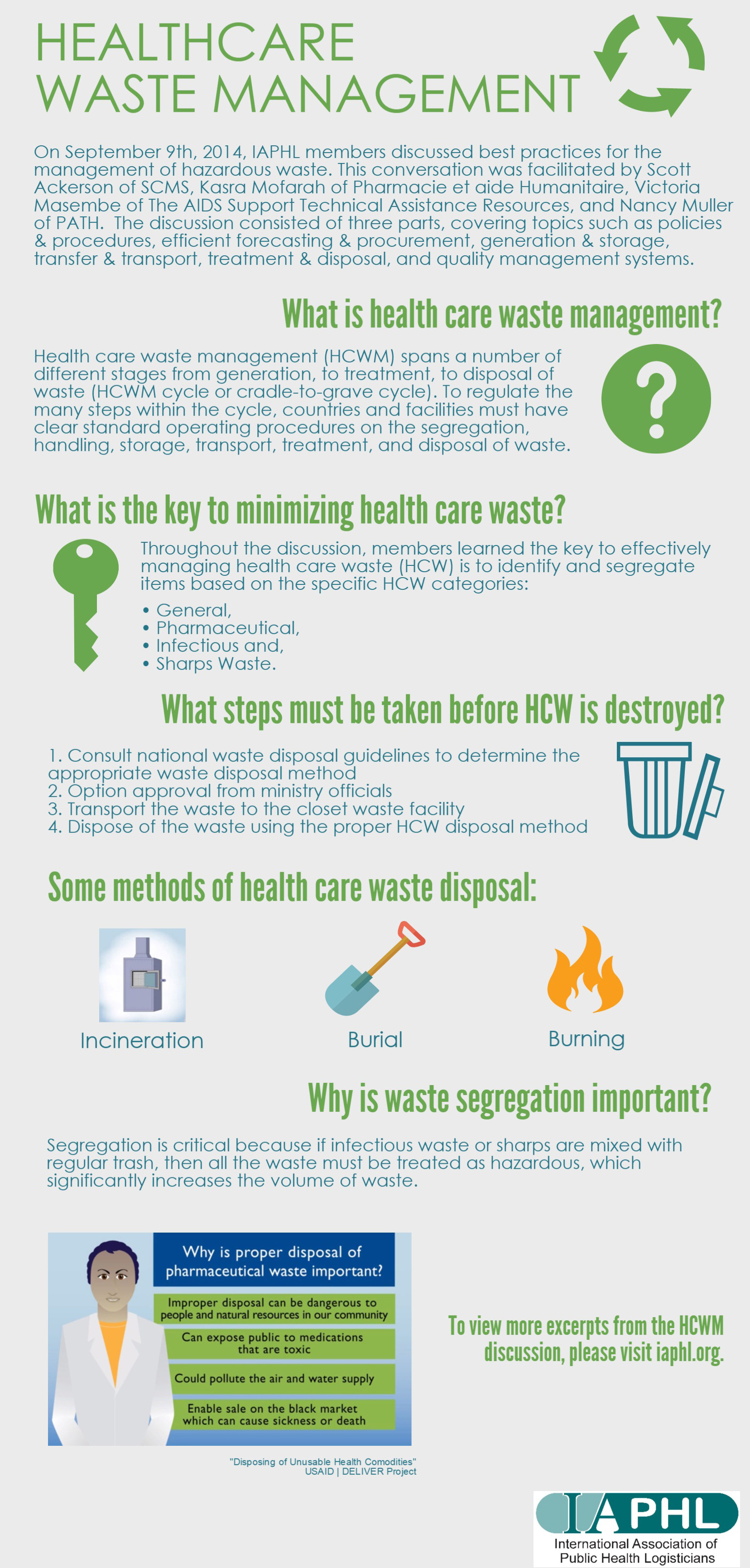 On September 2014, IAPHL members discussed best practices for the management of hazardous waste. This conversation was facilitated by Scott Ackerson of SCMS, Kasra Mofarah of Pharmacie et aide Humanitaire, Victoria Masembe of The AIDS Support Technical Assistance Resources, and Nancy Muller of PATH. The discussion consisted of three parts, covering topics such as policies & procedures, efficient forecasting & procurement, generation & storage, transfer & transport, treatment & disposal, and quality management systems.
On September 2014, IAPHL members discussed best practices for the management of hazardous waste. This conversation was facilitated by Scott Ackerson of SCMS, Kasra Mofarah of Pharmacie et aide Humanitaire, Victoria Masembe of The AIDS Support Technical Assistance Resources, and Nancy Muller of PATH. The discussion consisted of three parts, covering topics such as policies & procedures, efficient forecasting & procurement, generation & storage, transfer & transport, treatment & disposal, and quality management systems.
Selected comments from IAPHL members:
“To ensure proper management, a successful HCWM plan should:
- Clearly define the point of generation within the service site(s) (e.g., blood-drawing area, operating theater and recovery area)
- Propose HCWM product requirements/specifications
- Develop procedures and job aids for the identification, segregation, storage, transport, treatment, and disposal of health care waste
- Develop a quality management system
- monitoring and incident reporting system
- Set standard requirements for clinical staff safety and training (e.g., training schedule, personal protective equipment, cleaning, and personal hygiene)
- Propose environmentally sound treatment and disposal methods
- Define responsibilities of clinical staff, administration, regional and local government
Examples of nationals policy and guidelines:
1. Kanya National policy on injection safety:
http://www.path.org/files/Kenya-NationalPolicyoninjection.pdf
2. Swaziland national guidelines on health care waste management:
http://scms.pfscm.org/hcwm/docs/Swaziland%20National%20HCWM%20Guidelines.pdf“–Scott Ackerson “There is need for good policies and all but strong monitoring of the processes needs to also
be strenghtened.”–Rahman Olasunkanmi Kelani “The updated guidance follows WHO guidelines for management of infectious waste [in the context of the Ebola virus] but recommends more stringent precautions. These include:
- hand hygiene
- use of disposable medical examination gloves before contact with body fluids, mucous membrane, non-intact skin and contaminated items, and
- gown and eye protection before procedures and patient-care activities likely to involve contact with or projection of blood or body fluids.
These same precautions are recommended for aides, cleaners, and waste handlers. The Guidelines note that additional PPE, depending on performed tasks and risk assessment, may include:
- waterproof apron, if gown is not impermeable;
- disposable overshoes and leg coverings, if boots are not available;
- heavy duty (rubber) gloves, when performing environmental cleaning or handling waste;
- particulate respirator (FFP2 or EN certified equivalent or US NIOSH-certified N95), when performing procedures that promote generation of aerosols.”—Nancy Muller
“To support the sustainability of standards, an appropriate Quality Management System (QMS) should be developed and implemented. A QMS will provide a framework through which the hospital or health care facility can monitor and continuously improve all aspects of their environmental hygiene system. A QMS is meant to empower its employees to strengthen their environmental hygiene system and increase safety within their work processes and work environment.”– Scott Ackerson “Lessons Learned [in the Ebola House to House campaign strategy]:
- Planning is key despite the timings and constraint-
- Result can be achieved if there is proper coordination.
- Despite the emergency always take a breath and develop strategies to guide you in achieving this.”– Yambalu Mbalia Conteh
